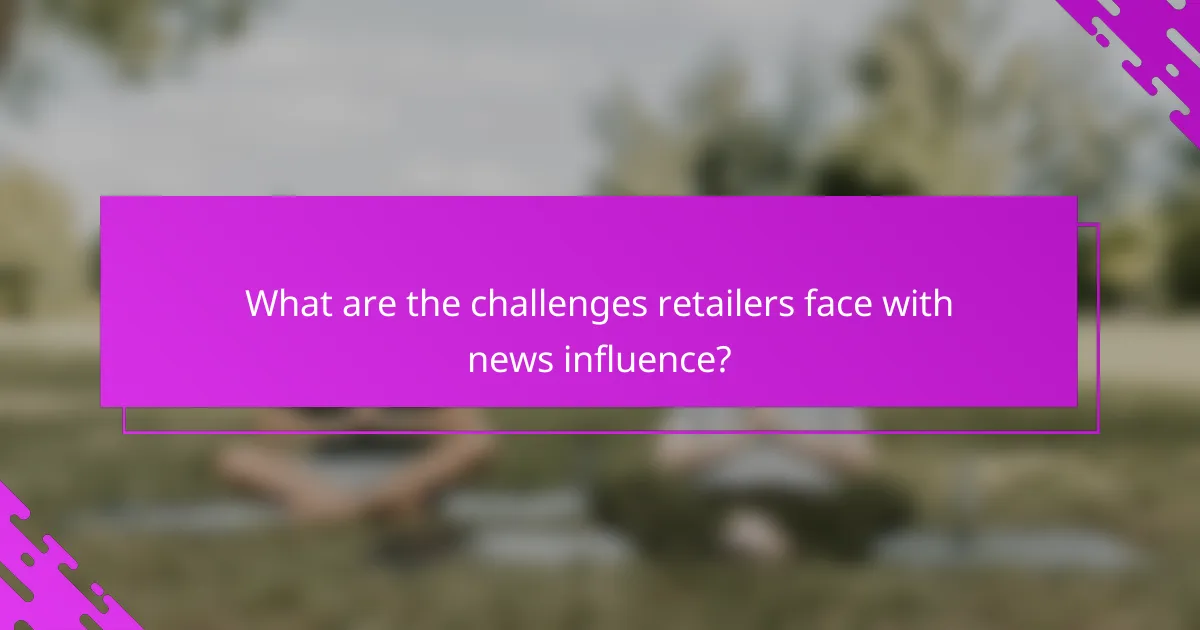News plays a crucial role in shaping consumer behavior within the retail sector, influencing perceptions, attitudes, and purchasing decisions. The information conveyed through various media channels can create urgency and alter brand perceptions, ultimately impacting market trends. By understanding the emotional responses and trust consumers place in news sources, retailers can enhance their marketing strategies and connect with their audience more effectively.

How does news influence consumer behavior in the retail sector?
News significantly shapes consumer behavior in the retail sector by affecting perceptions, attitudes, and purchasing decisions. Information disseminated through various media channels can create urgency, alter brand perceptions, and influence market trends.
Impact of news on purchasing decisions
News can directly impact purchasing decisions by highlighting product recalls, safety concerns, or positive reviews. For instance, a negative news story about a brand can lead to a swift decline in sales, while positive coverage can boost consumer interest and sales figures. Retailers must monitor news cycles to adapt their strategies accordingly.
Moreover, time-sensitive news can create a sense of urgency among consumers, prompting quicker purchasing decisions. For example, limited-time offers or sales announced through news outlets can drive immediate traffic to stores or websites.
Role of social media in consumer perception
Social media amplifies the influence of news on consumer perception by allowing rapid sharing and discussion of news stories. Platforms like Twitter and Facebook can spread information quickly, shaping public opinion and consumer behavior almost in real-time. Brands that engage with consumers on social media can mitigate negative perceptions or enhance positive ones.
Additionally, user-generated content and reviews shared on social media can influence potential buyers. Consumers often rely on peer opinions over traditional advertising, making it crucial for retailers to maintain a positive online presence and respond to news-related discussions.
Case studies of news-driven retail trends
Several case studies illustrate how news has driven retail trends. For example, during the COVID-19 pandemic, news coverage of health guidelines led to a surge in online shopping as consumers sought safer purchasing options. Retailers that quickly adapted to e-commerce saw significant growth during this period.
Another example is the rise of sustainable products, driven by news coverage on climate change. Consumers increasingly prefer brands that demonstrate environmental responsibility, prompting retailers to adjust their product offerings and marketing strategies to align with these values.

What are the key factors driving consumer decision-making?
Key factors driving consumer decision-making include emotional responses to news, trust in news sources, and brand reputation shaped by news narratives. These elements significantly influence how consumers perceive products and make purchasing choices.
Emotional responses to news coverage
Emotional reactions to news coverage can greatly impact consumer behavior. For instance, positive news about a product can create excitement and lead to increased sales, while negative coverage can deter potential buyers. Consumers often rely on their feelings about news stories when deciding whether to engage with a brand.
Retailers should monitor news sentiment and adjust their marketing strategies accordingly. For example, if a competitor faces negative publicity, a brand might highlight its own positive attributes to attract those disillusioned consumers.
Trust in news sources
Trust in news sources plays a crucial role in shaping consumer decisions. When consumers trust the media outlet delivering information, they are more likely to act on that information. Conversely, distrust can lead to skepticism about product claims and brand messaging.
Brands should focus on transparency and credibility in their communications. Engaging with reputable news outlets and influencers can enhance trustworthiness, making consumers more receptive to marketing messages.
Brand reputation and news narratives
Brand reputation is often influenced by the narratives presented in news coverage. Positive stories can enhance a brand’s image, while negative reports can tarnish it. Consumers frequently use news narratives to form opinions about a brand before making a purchase.
To manage brand reputation effectively, companies should proactively address negative news and promote positive stories. Regularly engaging with customers through social media and public relations can help shape a favorable narrative and maintain consumer trust.

How can retailers leverage news to enhance marketing strategies?
Retailers can enhance their marketing strategies by integrating relevant news into their campaigns, allowing them to connect with consumers in meaningful ways. By staying updated on current events and trends, retailers can tailor their messaging to resonate with their audience and drive engagement.
Integrating news into advertising campaigns
Incorporating news into advertising campaigns can create timely and relevant content that captures consumer attention. For instance, a clothing retailer might launch a promotion tied to a major sporting event, using related imagery and messaging to attract fans. This approach not only boosts visibility but also aligns the brand with current interests.
When integrating news, ensure that the messaging is authentic and aligns with the brand’s values. Misleading or forced connections can backfire and damage credibility. Focus on creating a narrative that feels natural and engaging to the target audience.
Real-time marketing based on news events
Real-time marketing involves responding to breaking news or trending topics to engage consumers immediately. For example, a food brand might promote a recipe using their products during a viral cooking trend, leveraging social media to maximize reach. This strategy can generate significant buzz and drive traffic to the retailer’s website.
To effectively implement real-time marketing, establish a process for monitoring news and trends. Utilize social media listening tools to identify relevant topics and prepare a flexible content calendar that allows for quick adaptations. However, be cautious of jumping on every trend, as not all will align with your brand identity.
Collaborations with news outlets
Partnering with news outlets can provide retailers with credibility and access to a broader audience. Collaborations might include sponsored content, interviews, or product placements within news segments. For instance, a tech retailer could work with a technology news site to feature their latest gadgets in a product review segment.
When collaborating with news outlets, choose partners that share similar values and target demographics. This alignment ensures that the partnership feels authentic and beneficial for both parties. Additionally, consider the regulatory implications of advertising in news media, especially regarding transparency and disclosure requirements.

What metrics should retailers track to measure news impact?
Retailers should focus on key metrics that reflect how news affects consumer behavior and sales. Important areas to monitor include consumer engagement analytics, sales performance correlation with news cycles, and brand sentiment analysis.
Consumer engagement analytics
Consumer engagement analytics measure how news influences interactions with a brand across various platforms. Metrics such as website traffic, social media mentions, and email open rates can provide insights into consumer interest and behavior following significant news events.
Retailers should track engagement spikes during news cycles to understand which topics resonate with their audience. Tools like Google Analytics and social media insights can help identify trends and patterns in consumer engagement.
Sales performance correlation with news cycles
Analyzing sales performance in relation to news cycles helps retailers determine the direct impact of news on purchasing decisions. By comparing sales data before, during, and after major news events, retailers can identify correlations that inform marketing strategies.
For example, a retailer may notice a surge in sales of specific products following positive news coverage. Tracking these patterns can help retailers optimize inventory and promotional efforts in response to emerging news trends.
Brand sentiment analysis
Brand sentiment analysis gauges consumer feelings and attitudes towards a brand in light of news coverage. This can be assessed through social media sentiment analysis tools, customer feedback surveys, and online reviews.
Retailers should monitor sentiment shifts during news events to understand public perception. A significant drop in positive sentiment may indicate a need for crisis management or targeted communication strategies to restore brand image.

What are the challenges retailers face with news influence?
Retailers encounter several challenges due to the influence of news, including managing misinformation, adapting to rapid news cycles, and balancing brand messaging with prevailing news narratives. These factors can significantly impact consumer behavior and decision-making processes.
Managing misinformation
Misinformation can spread quickly through news outlets and social media, leading to consumer confusion and mistrust. Retailers must actively monitor news coverage and public sentiment to identify and address false information that may affect their brand.
To combat misinformation, retailers can implement clear communication strategies, such as issuing fact-checks or clarifications through their official channels. Engaging with customers directly on social media can also help to dispel myths and reinforce trust.
Adapting to rapid news cycles
The fast-paced nature of news cycles requires retailers to be agile and responsive. Retailers must stay informed about current events and trends to adjust their marketing strategies and inventory accordingly, ensuring they meet consumer demands.
Establishing a dedicated team to monitor news and analyze its potential impact on consumer behavior can be beneficial. Retailers should also consider flexible marketing plans that allow for quick pivots in response to emerging news stories.
Balancing brand messaging with news narratives
Retailers face the challenge of aligning their brand messaging with ongoing news narratives without appearing opportunistic. Striking the right balance is crucial for maintaining brand integrity and consumer trust.
To achieve this balance, retailers should develop messaging that is relevant to current events while remaining true to their core values. Collaborating with public relations experts can help craft messages that resonate with consumers and reflect the brand’s commitment to social responsibility.

How does news consumption vary across different demographics?
News consumption differs significantly among various demographics, influenced by factors such as age, education, and socioeconomic status. Understanding these variations can help businesses tailor their marketing strategies and communication efforts effectively.
Age-related news consumption patterns
Age plays a crucial role in how individuals consume news. Younger generations, particularly those under 30, tend to prefer digital platforms like social media and news apps, while older adults often rely on traditional media such as television and newspapers. This shift highlights the importance of adapting content delivery methods to reach diverse age groups.
For instance, individuals aged 18-24 may spend only a few minutes daily on news, often skimming headlines on social media. In contrast, those over 50 might dedicate more time, often engaging with in-depth articles or televised news reports. Businesses should consider these patterns when developing content strategies to engage their target audience effectively.
Marketers can leverage these insights by creating age-specific campaigns. For example, using short, visually engaging content for younger audiences and more comprehensive, detailed articles for older demographics can enhance engagement and retention rates.


